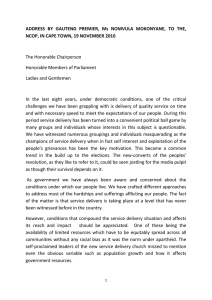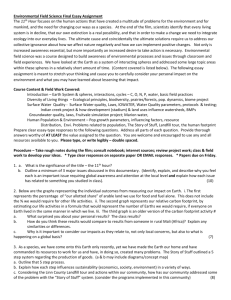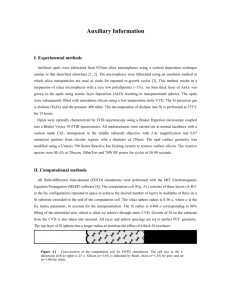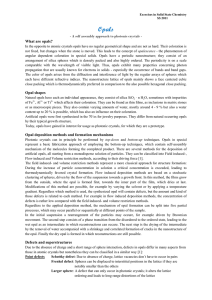Opaline Photonic Crystals: How Does Self-Assembly Work? David J. Norris See: μm
advertisement
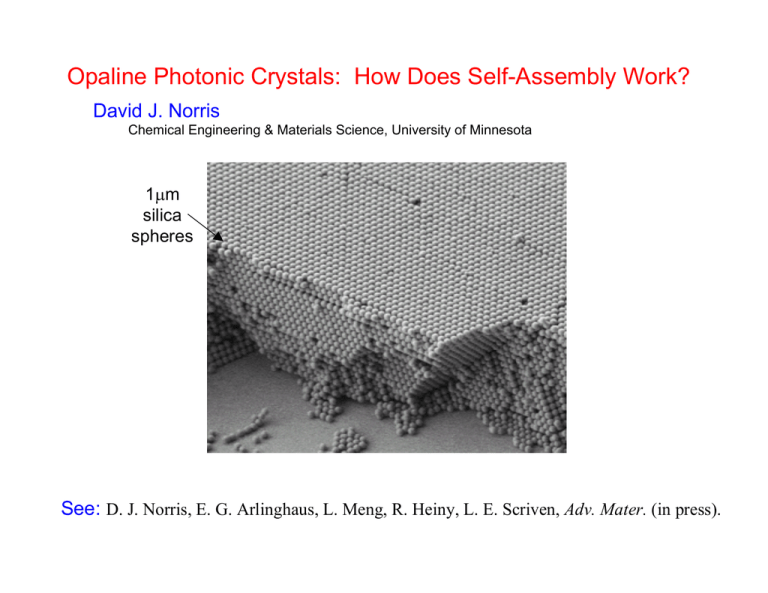
Opaline Photonic Crystals: How Does Self-Assembly Work? David J. Norris Chemical Engineering & Materials Science, University of Minnesota 1μm silica spheres See: D. J. Norris, E. G. Arlinghaus, L. Meng, R. Heiny, L. E. Scriven, Adv. Mater. (in press). What is Self-Assembly? Science 295, 2418 (2002). Definition: “Self-assembly is the autonomous organization of components into patterns or structures without human intervention.” Further: Includes “processes that involve pre-existing components (separate or distinct parts of a disordered structure), are reversible, and can be controlled by proper design of the components.” spontaneous ordering of “building blocks” Examples: Formation of molecular crystals Folding of globular proteins Background: Use self-assembly to obtain photonic crystals? natural gemstone opal 0.2μm silica (glass) spheres Sanders; Nature 204, 1151 (1964) Motivation: Ideal material for controlling light • Light now used in telephone & internet traffic • Need small circuits to control these optical signals • Photonic crystals in future optical technologies? Our Approach to Photonic Crystals: Colloidal Self-Assembly sub-micron colloidal spheres Template (synthetic opal) 3D Infiltration Literature Results: O. D. Velev et al., Nature 1997, 389, 447. D. Pine et al., Nature 1997, 389, 948. G. Stucky et al., Science 1998, 279, 548. A. Stein et al., Science 1998, 281, 538. W. Vos et al., Science 1998, 281, 802. A. A. Zakhidov et al., Science 1998, 282, 897. T. E. Mallouk et al., Science 1999, 283, 963. V. L. Colvin et al., PRL 1999, 83, 300. A. Blanco et al., Nature 2000, 405, 437. Remove Template Theory: inverted opals have a PBG Haus et al., PRB, 45, 13962 (1992). Busch and John, PRE, 58, 3896 (1998). “Inverted Opal” Requires refractive index > 2.85 Silicon Inverted Opal in collaboration with X. –Z. Bo and J. Sturm (Princeton) 850nm silica spheres Si wafer amorphous silicon Si deposition reactive ion etch acid etch Sedimentation: Synthetic Opals silica ~0.5μm Sediment Crystal 8 microns dry and collect sediment synthetic opal Even Better: Thin Opaline Films 1μm silica spheres Opaline films Convective Self-Assembly meniscus Colvin et al., Chem. Mater. (1999) glass slide evaporate solvent silica 250nm • Capillary forces during drying cause assembly in the meniscus • Extremely flat, large-area opals of controllable thickness • Limited by gravity to spheres <400nm? Problem with larger spheres: sedimentation evaporation gravity For larger spheres . . . • spheres sediment away from the meniscus region • deposition cannot take place Add Temperature Gradient meniscus 1 micron silica spheres in ethanol 65C evaporate solvent 80C For larger spheres . . . Heat Source • add temperature gradient across vial • constantly supply spheres to meniscus • make large sphere planar opals Large sphere opals are necessary to have photonic band gap at λ = 1.5μm. But how does the assembly process work? meniscus evaporate solvent Questions: • Mechanism that controls the formation of multilayers? • With understanding, can we reduce disorder? • Assemble other structures? Consider connections to three related areas: 1. Monolayer formation (Denkov, Kralchevsky, Nagayama, Velev, and coworkers) evaporation liquid evaporate liquid spheres assemble • • • • Liquid interface induces partially immersed spheres to close-pack Liquid evaporating from the spheres brings in more liquid Liquid flow brings in more spheres Ordered monolayer develops But what about multilayers? Consider connections to three related areas: 2. “Latex” Coatings • Heavily studied • Industrially important • 3 stages: consolidation compaction coalescence • Ordering has been observed • Solvent evaporation causes viscous drag that forms “pack” • If evaporation is halted, spheres redisperse • Solvent flow is important! see J. L. Freddie, Mater. Sci. Eng. R 1997, 21, 10. from Z. Huang, Ph.D. Thesis, Univ. of Minnesota, 2001. Consider connections to three related areas: 3. Opals & Colloidal Crystals natural gemstone opal 0.2μm silica (glass) spheres Sanders; Nature 204, 1151 (1964) Unlike deformable latex spheres, here we have non-deformable “hard spheres” How do “hard-spheres” pack? hexagonal sheets of spheres stack 2 possibilities HCP FCC • Two possible crystal structures: HCP and FCC • Both have the same packing volume (74%) at zero temperature. • Also can have randomly stacked (i.e. ABACBCAC . . .) or random hexagonal close-packed (RHCP). Theory Thermodynamics: FCC slightly lower in free energy • See: Woodcock, Nature, 385, 141 (1997). Bolhuis et al., Nature, 388, 235 (1997). Mau and Huse, Phys. Rev. E, 59, 4396 (1999). • Subtle effect: differences in 3rd nearest neighbors • Energy difference small: ~10-3 kbT FCC Natural Opals • Most natural opals are RHCP • Although in rare cases, FCC is observed • See: Sanders, Nature, 204, 1151 (1964). Sanders, Acta Cryst. A, 24, 427 (1968). Sedimented synthetic opals silica ~0.5μm Sediment Synthetic Opal 8 microns structure depends on sedimentation time Sedimented synthetic opals • Opals sedimented over months: preference for FCC • Thermodynamics controlling crystal structure? But important side comment . . . Solvent flow may be important! Back to convective assembly: meniscus evaporate solvent Questions: • Mechanism that controls the formation of multilayers? • With understanding, can we reduce disorder? • Assemble other structures? Summary of observations: thermodynamics natural opals synthetic opals (quick sedimentation) synthetic opals (slow sedimentation) opaline coatings (made in hours) favors FCC slightly typically random (RHCP) random (RHCP) FCC FCC?? What is controlling crystal structure in convective assembly? To study: visualize opal growth immersion oil microscope objective CCD 100X 800nm spheres video camera Visualization of Opal Growth 800nm spheres microscope objective real time video CCD 100X immersion oil video camera Analysis evaporation immersion oil 1 0 0X microscope objective • • • • Evaporation causes dramatic flows of fluid and spheres Spheres get sucked into place by the flow Unlikely that structure forms in thermodynamic equilibrium But, we obtain the lowest energy form - FCC WHY?? Fluid-Driven Assembly • Solvent flow drives the assembly • Solvent flow controls the crystal structure? • Consider two cases . . . flow into crystal face flow with component along the crystal face Solvent Flow Into Crystal Face Model Flow Though Interstitials (“Resistors in Parallel”) clear from E. G. Arlinghaus, Ph.D. Thesis, University of Minnesota, 2004. obstructed Solvent Flow Into Crystal Face 33% more flow! Could explain FCC structure! Lateral Solvent Flow exposed niche sheltered niche Lateral Solvent Flow Could explain FCC structure! from E. G. Arlinghaus, Ph.D. Thesis, University of Minnesota, 2004. Concluding Thoughts: • Both possibilities lead to FCC structure! • Are these flow mechanisms playing a role? • If so, it is non-traditional self-assembly • Further work necessary to understand • Utilize to further eliminate defects in our opals? • Use fluid flow to create other structures? • Use different shape building blocks? • What new materials will this allow us to create? Acknowledgements: L. Meng, B. Wiley R. Heiny Y. Jun Dr. E. Arlinghaus Prof. L. E. Scriven Financial Support: University of Minnesota, IPRIME NSF MRSEC, NSF-CTS, PRF


